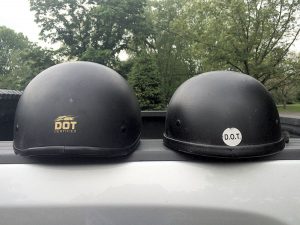May is Motorcyle Safety Awareness Month
By Jay Cook
The old motorcycle adage ‘loud pipes save lives’ is considered by many riders to be gospel.
But to motorcycle education instructors, it is misleading. Loud pipes do not save lives; education does.
“You have loud pipes? That doesn’t save anybody’s life. Everyone with a half a brain knows it doesn’t,” says Dave Fairlie, head instructor with Rider Education of New Jersey, a non-profit organization that offers motorcycle education classes in New Jersey.
Fairlie has been teaching motorcycle safety for 18 years at five community colleges in the state. At last weekend’s course at Brookdale Community College in Lincroft, which fell in Motorcycle Safety Awareness Month, he began the way he always does, underscoring the challenge of motorcycle awareness on the roads. “Before you got the inkling to ride – did you see a lot of motorcycles on the road?” he asked his 30 students. As usual, most replied, “No.”
Assistant site coordinator Bob Blasi, who also was an enrollee in RENJ’s early years, reinforces one main topic to his bikers in each session. “We try to promote awareness here, whether it be self-awareness of a rider and their surroundings or the overall awareness of what you’re controlling,” he said.
According to the most recent data from the New Jersey State Police, there were 371 fatal motorcycle crashes in the state between 2010-2014. In the 2014 Governor’s Highway Safety Association report, it states that motorcycles are only 3 percent of all vehicles on the road, yet they comprise a staggering 14 percent of all motor vehicle fatalities.
Throughout the three-day education course, paying students learn the rules of the road, where to find the controls and the proper way to lean into a turn, among other things. They are encouraged to get a feel for the motorcycle by sitting on one. The second and third days are dedicated to starting, stopping, shifting and turning, the four main functions needed to ride safely either on a cruiser or sports bike.
Fairlie also makes it a point to focus on the correct gear each biker should have. While goggles, long pants and firm shoes all share equal importance, one other item trumps them all – the helmet. “Our job is to educate. If I could show you the benefits of a helmet or proper protective gear, and you fully understand that, and yet you make a conscious choice to do otherwise, that’s up to you.”

New Jersey is one of 19 states that require riders to wear a helmet, which must meet state Department of Transportation, or DOT, standards. The National Highway Traffic Safety Administration conducted a survey in 2014 which found that 89 percent of riders in states with helmet laws wore DOT helmets. Seven percent of riders who did not meet these guidelines wore what are known as “novelty” helmets.
For motorcycle dealers who also sell accessories, having the legal and correct protective equipment is paramount. “It should be illegal to sell those helmets, and there’s cops on detail for that reason,” said Jimmy Reda, owner of Jersey Shore Powersports on Route 35 in Middletown. Reda also pointed out that novelty helmets are usually sold at swap meets and flea markets.
Commonly referred to as “brain buckets” by motorcyclists, these helmets provide little to no protection for riders. “I always just refer to them as ‘Tupperware buckets.’ Unfortunately, we see too many people that ride around with those things on, and no, they don’t really afford any type of protection,” said Bob Pfleger, chief of the Middletown Township EMS. “I’ve had plenty of calls where if somebody had a real helmet on, they would be in a lot better shape than they were when I got to them.”
Next month will be Pfleger’s 40th year as a first responder, and he said he “couldn’t even imagine” the number of motorcycle crashes he has seen in his tenure. He was also on scene for the fatal crash that occurred on May 15 on West Front Street in Lincroft, when motorcyclist Marc Gardner, 62, of Long Branch died on a hilly, narrow stretch of West Front Street, between Shady Oaks Way and Stevenson Park. “I was in command of that call,” said Pfleger. “I don’t know what the circumstances were, but essentially the gentleman on the bike, where the road has a slight bend to the left, he just drove straight into a tree.”
Not all crashes are fatal though. Charlie Webster, the public information officer of the Monmouth County Prosecutors Office, was a lucky one. On June 20, 2012, Webster was involved in a crash on his motorcycle, when he was cut off by a driver on the Garden State Parkway as he approached southbound Exit 98.
“I had a helmet on at the time; it was a half helmet, like a lot of riders,” said Webster. “When I landed on the ground, I came off my bike at about 65 miles an hour. I stopped rolling about a foot away from the guard rail. If my head would have hit that guard rail, who knows what would have happened,” he said. His four-month-old Harley Davidson Super Glide Custom was totaled in the accident.
The Rider Education of New Jersey program offers courses every year from April through October. The Brookdale Community College course in Lincroft has classes every single weekend, regardless of weather. The Basic Rider Course, otherwise known as the BRC, costs $300 for the Friday-Sunday course. Attendance is mandatory on all three days for graduation. For further information about the courses and their availability, see RENJ.com.














